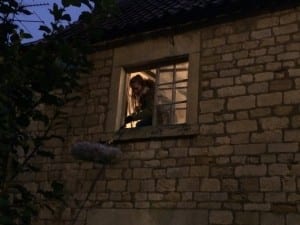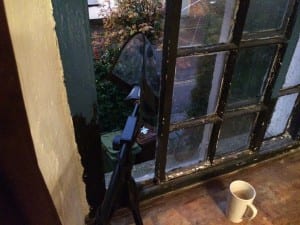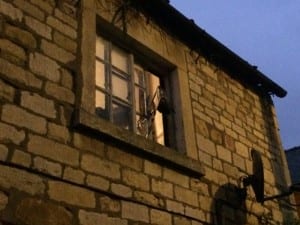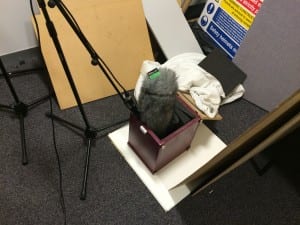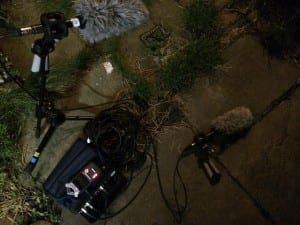The Green Mile was suggested by George’s original director as a film from which she drew some influence for the piece. Released in 1999 (US), it was produced on a budget of $60 million and returned $290 million, and was a vehicle for a number of big name Hollywood actors including Tom Hanks. It is a supernatural crime drama adapted from the Stephen King novel of the same name.
The sound designer for The Green Mile was Mark Mangini, a 3o year veteran of Hollywood film-making and responsible for a broad variety of films from Shark Tale to Mad Max – Fury Road. He has run a post-production sound company in Hollywood for 25 years, and is currently a Governor of the Academy of Motion Picture Arts and Sciences.
“A sound designer is, simply, somebody who uses sound creatively to tell a story,” – Mark Mangini
The audio in Green Mile is grounded in gritty realism of the classic prison setting but also portrays the abstract realm of magic or the brutality of execution, and the writer / director Frank Darabont said that audio played an even more important role than usual as that dimension of his film is ‘…all about special little sounds, or even enormous sounds sometimes…that are given place in the movie,’ – (Cinema Secrets). He asked Mangini to make the ‘Green Mile’ part of the set itself a central character in the film through it’s sound design.
Taking this onboard, I tried to ensure my own approach to designing and editing the atmospheres for ‘George’ involved something similar. The house in which the character lives was designated as his ‘safe space’ by the director, and we discussed making this explicit with the sound dimension, in support of the characters story. We built peaceful atmospheres whenever George was at home and highlighted these with the sounds of the outside world trying to get in as his level of tension and anxiety increased (I discuss the outcome of this component of the sound script in this post).
Elsewhere, I decided to follow Mangini’s lead in Green Mile with my own approach to some of our foley sound design. Some of the foley in the film was recorded at the original sets after shooting had wrapped, which Mangini points out offered them an ‘…identical acoustic space’ to create in, and was recorded and directed via fibre optic link to a local studio. It wasn’t necessary to remotely record our foley, but I did return several times to the house location in George with a portable recording setup when I was unable to satisfactorily recreate perspectives in the edit, most notably the sound of kids running away outside through the walls and door of the building and footsteps on the stone flags and oak floors of the house.
“My goal through that whole sequence was to re-purpose and recycle critical sounds as clues and metaphor.” – Mark Mangini
Here’s a final aspect of Green Mile’s design which we used explicitly throughout George. Our soundtrack is woven with reused references to the characters past in exactly the same way as the flashback sequence in the film, melded with action on screen both subtly and noticably, as well as with the music track to an extent.
Moving away from Green Mile but staying with Mark Mangini and in the context of reflection on George, the following interview quote is useful –
“In other words, it’s all about the context. If a scene is working, is truly scary, just about any sound you use could work. We struggled a great deal with the lecture hall scenes and tried exhaustively to create what became illusory goal: making what was meant to be ‘real’ exorcisms on screen sound frightening. I think this was our sonic “Waterloo”. By that I mean, there is always one sound, one elusive sound, on every film where an inordinate amount of time and resources are spent in trying to achieve a goal that will never be achieved and failure is inescapable, for whatever reasons; the filmmakers don’t know what they want or can’t decide, the action on screen doesn’t carry it’s weight dramatically, etc. As is typical in many post-sound endeavors, we accepted what we had as the best we could do and called it a day.” – Designing Sound
For me, the picture dimension of George does not manage to carry it’s weight dramatically in some key scenes, and reviewing the final product I get the impression of the soundtrack as somewhat ‘out on it’s own’ in trying to convey the themes in the script at times. Our own ‘sonic waterloo’ was probably the graveyard dialogue track, which doesn’t quite work in terms of perspective despite at least three different approaches to try and fix a problem which essentially arose from problems with our location audio and no potential for access to the actor for ADR after the fact. In the end with this, we accepted we’d done our best and moved on as described above.
– 850 words
———————————————
Key Points –
Research of the film ‘Green Mile’ and it’s sound designer Mark Mangini – Planning & Research
- To expand my knowledge of the theory and audio techniques deployed in the films influencing ‘George’, and in drama as a genre more generally.
Assess the technical requirements of a production to inform the selection of appropriate tools, techniques and processes
Reflection on specific aspects of the completed sound design of George informed by reference material and research – Application of skills and conduct in production
- To judge the initial direction of and maintain the consistency of the overall tone of the audio team’s work on the piece, and liase with the director to ensure this is concurrent with their vision of the piece.
- To manage the post-production workflow and direct the creative contributions of the audio team as efficiently as possible.
- Develop creative, original, and innovative strategies within an audio production project.
- Structure intellectually rigorous and coherent ideas to an advanced level in order to communicate ideas through the integration of form and content.
- Individual reflection on learning and team role.
